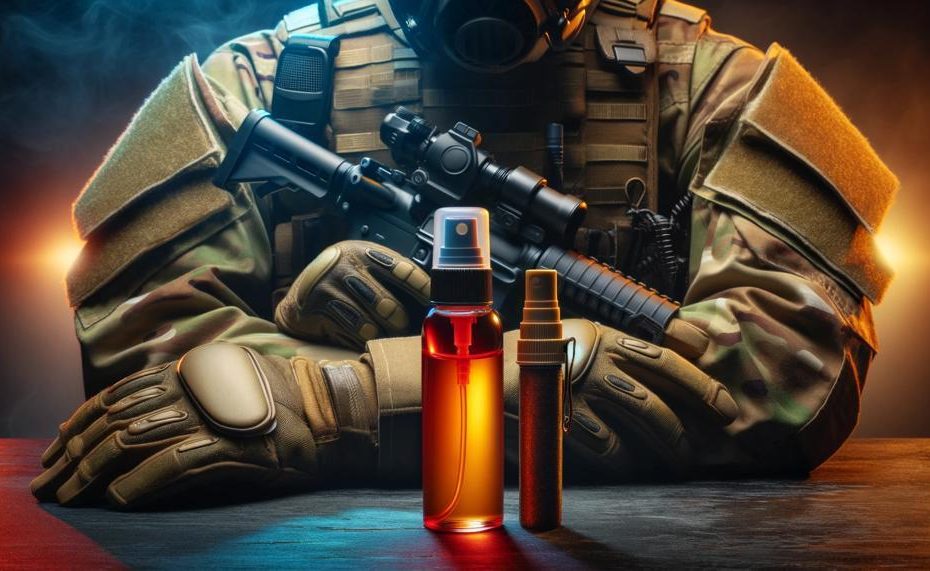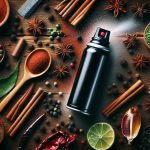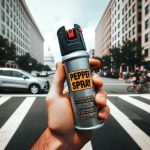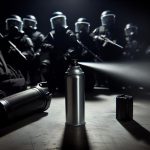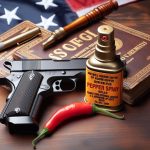In today’s world, personal safety is a top priority for many people.>
Whether you’re a runner going on solo workouts or a college student walking home at night, having a reliable form of defense is crucial. That’s where pepper spray and gel come in – two popular self-defense tools that have been used for decades.
But with so many options on the market, it can be overwhelming to choose between the two. That’s why we’ve created this informative blog post to help you make an informed decision.
In this post, we’ll delve into the key differences between pepper spray and gel, including their effectiveness, range, and ease of use. We’ll also discuss the advantages and disadvantages of each option so you can determine which one is best suited for your personal safety needs.
So let’s dive in and explore the world of pepper spray vs gel – because when it comes to protecting yourself, knowledge is power.
Contents
- 1 Unpacking Pepper Spray
- 2 Pepper Gel vs. Spray: A Comparative Analysis
- 3 Usage Scenarios: When to Use Which
- 4 Safety Precautions
- 5 Getting to Know the Active Ingredient: Capsaicin
- 6 How Do They Affect the Human Body?
- 7 Legal Considerations
- 8 Choosing the Right Product for You
- 9 Storing and Maintaining Your Pepper Spray or Gel
- 10 Conclusion
Unpacking Pepper Spray
Pepper spray and pepper gel are both widely used as non-lethal self-defense weapons, but they have distinct characteristics that can significantly impact their effectiveness in survival scenarios.
These key differences include ease of use, range, safety, cost, and individual preferences.
| Characteristic | Pepper Spray | Pepper Gel |
| Ease of Use | Compact size and a simple trigger mechanism make it easy to access without specialized training or skills. | Features such as ergonomic grips, finger-loop triggers, and safety locks make it more user-friendly and less prone to accidental discharge. |
| Range | The standard consumer-grade options have an effective range of 6 to 12 feet, while law enforcement variants can reach up to 25-30 feet. | The thicker consistency and concentrated stream delivery system allow for an average reach of 15 feet or more. |
| Safety | Pepper spray is generally considered safe when used correctly, but it is susceptible to wind dispersion or blowback. | The adhesive nature of pepper gel results in a lower risk of wind dispersion or blowback. |
| Cost | Pepper spray is more affordable due to its simpler production process and wider market competition. | Pepper gel is slightly more expensive due to its unique formulation and packaging design. |
| Purpose | Pepper spray compensates for aim by covering a wider area. | On the other hand, pepper gel is more compact and accurate. |
| Individual Preference | For those who prioritize wider coverage area and affordability, pepper spray is the preferred choice. | However, if longer range and wind resistance are crucial considerations, then opting for pepper gel is recommended. |
In conclusion, when choosing between pepper spray and pepper gel, individual preferences and specific survival requirements play a significant role. For wider coverage area and affordability, pepper spray is the better option. However, if longer range and wind resistance are crucial considerations, then opting for pepper gel is recommended.
Pepper Gel vs. Spray: A Comparative Analysis
When it comes to self-defense, pepper spray and pepper gel are two popular options. Both can be effective, but they have some notable differences in terms of their effectiveness and safety.
Let’s take a closer look at these two options and compare them side by side.
| Pepper Spray | Pepper Gel |
| Comes in liquid form | Available in gel form |
| Has a wider dispersal pattern | Offers increased accuracy |
| Easier to use in high-stress situations | Can reach longer distances |
| Suitable for close-quarters encounters or dealing with multiple attackers | Reduced risk of blowback or inhalation in windy conditions or when dealing with an attacker from a distance |
| An affordable option for self-defense | A more expensive alternative |
| Potential for blowback and inhalation by the user in enclosed spaces or windy conditions | A safer option with reduced risk of blowback and inhalation for the user |
| May cause skin irritation or temporary burning sensation for the attacker lasting about 30 minutes or more | Slightly longer lasting effects on the attacker due to its thicker consistency and slower evaporation rate |
Pepper spray is a popular choice for self-defense due to its affordability and ease of use. However, it can also have some drawbacks, such as potential blowback and inhalation by the user. On the other hand, pepper gel may be a more expensive option, but it offers increased accuracy and reduced risk of blowback and inhalation.
Its thicker consistency also means that its effects on the attacker may last slightly longer.
Usage Scenarios: When to Use Which
Pepper spray and gel are both effective self-defense tools, but they have different strengths and weaknesses that make them ideal for specific scenarios.
Here, we will discuss the most common usage scenarios for both pepper spray and gel, as well as how individuals can determine which one is best suited for their specific needs.
| Pepper Spray | Pepper Gel | Comparison |
| Covers a wider area | Covers a narrower area | Pepper spray has a wider reach, making it ideal for situations with multiple attackers or in crowded areas. |
| Quick to take effect | Slower to take effect | Pepper spray works almost instantly, providing immediate relief from an attacker. However, pepper gel may take a few seconds longer to take effect due to its thicker consistency. |
| Can be affected by wind | Less affected by wind | Pepper spray can be easily affected by wind, making it less accurate in outdoor environments. Pepper gel, on the other hand, is less affected by wind due to its thicker consistency. |
| Potential harm to bystanders | Reduced risk of harm to bystanders | If not used carefully, pepper spray can cause harm to bystanders. Pepper gel has a more targeted stream and reduces the risk of blowback and inhalation for nearby individuals. |
| More affordable | Higher cost | In terms of affordability, pepper spray is the more budget-friendly option. However, pepper gel may be worth the investment for its increased accuracy and reduced risk of blowback and inhalation. |
To determine which option is best for you, consider the following factors: effective range, performance in different environments, required accuracy when aiming, potential for collateral damage, and personal comfort. For example, someone who frequently travels to crowded areas may prefer pepper spray for its wider coverage and affordability.
On the other hand, someone who lives in a windy area or wants more accurate aim may opt for pepper gel.
It’s also important to feel comfortable and confident in using these self-defense tools. Both pepper spray and gel may require training or practice to use effectively. Additionally, proper storage and maintenance are crucial for their effectiveness.
Safety Precautions
When it comes to utilizing pepper spray or gel for self-defense, it is essential to keep in mind that these tools are meant to safeguard you in perilous situations. Therefore, it is crucial to handle them carefully and follow safety precautions to ensure their effectiveness and your well-being.
Here are some important safety precautions to consider when using pepper spray or gel for self-defense:
- Know the laws: Before purchasing and carrying pepper spray or gel, it is essential to be aware of the laws and regulations in your area. Some states and countries have restrictions on the potency and amount of pepper spray that can be carried, while others may require a permit. Educate yourself on these laws and adhere to them to avoid legal ramifications.
- Practice proper handling: Pepper spray should only be used as a last resort in cases of imminent danger. It is imperative to handle it properly and avoid contact with your skin and eyes. When practicing with the spray, use a water-based inert training spray instead.
- Use it as a last resort: While pepper spray can be an effective tool for self-defense, it should only be utilized as a last resort when all other tactics have failed. Carefully assess the situation before using pepper spray and make sure you have exhausted all other options.
- Regular maintenance: To ensure the effectiveness of your pepper spray or gel, it is vital to regularly check expiration dates and do test sprays. This will help determine if your spray is still potent and ready for use.
- Be mindful of surroundings: When using pepper spray or gel, make sure you are aware of your surroundings. Avoid using it in crowded areas where innocent bystanders may be affected by the spray. Stay composed and focused on your target.
- Follow instructions: Different types of pepper spray may come with varying instructions for use. It is crucial to read and comprehend the instructions before using the product to avoid any accidents.
- Consider alternatives for animals: While pepper spray can be effective in deterring aggressive animals, it is essential to use specifically designed sprays for animals. Regular pepper spray may not be as effective or humane when used on animals.
- Replace expired spray: Pepper spray does have an expiration date and should be replaced once it has expired. An expired spray may not be as effective when needed, so it is crucial to check the expiration date and replace it accordingly.
- Remember it is just one tool: Pepper spray can be a valuable tool in self-defense, but it is vital to remember that it is just one tool in your safety arsenal. Be aware of other options and techniques for self-defense and do not solely rely on pepper spray.
By following these safety precautions when using pepper spray or gel for self-defense, you can ensure your safety and the effectiveness of the product.
Getting to Know the Active Ingredient: Capsaicin
Capsaicin is the main compound found in peppers that is responsible for the intense burning sensation when it comes in contact with sensitive tissues. In self defense weapons such as pepper spray and gel, it triggers the body’s pain receptors, temporarily incapacitating an attacker.
However, the effectiveness of these weapons relies heavily on the concentration of capsaicin and its ability to reach the attacker’s sensitive areas.
Other factors, including wind direction and individual tolerance, can also impact its overall effectiveness.
To fully understand how capsaicin affects pepper spray and gel as self defense weapons, let’s take a look at this table:
| Active Ingredient | Type of Weapon | Effectiveness |
| Capsaicin | Pepper Spray | Highly effective if used at appropriate concentration and reaches sensitive areas |
| Capsaicin | Pepper Gel | Highly effective if used at appropriate concentration and reaches sensitive areas from a distance |
As we can see, capsaicin is highly effective in both pepper spray and gel, as long as it is used at an appropriate concentration and reaches the attacker’s sensitive areas.
However, these two self defense weapons differ in their delivery methods. Pepper spray is a liquid solution that can be sprayed directly at an attacker, while pepper gel is a thicker substance that can be sprayed or shot from a distance. This difference may affect the effectiveness of these weapons in certain situations.
Aside from understanding the role of capsaicin, there are other crucial factors to consider in maximizing the effectiveness of pepper spray and gel. These include proper handling of the weapon, awareness of laws and surroundings, and regular maintenance. These can ensure that the concentration of capsaicin remains potent and that the spray or gel reaches its intended target effectively.
How Do They Affect the Human Body?
When used as a self-defense tool, pepper spray and gel can have various effects on the human body, including temporary discomfort, pain, and incapacitation. These effects are caused by the main ingredient, capsaicin, which irritates the eyes, respiratory system, and skin.
| Effect | Pepper Spray | Pepper Gel |
| Discomfort and Pain | Immediate burning sensation in eyes, throat, and skin. | Burning sensation in eyes, throat, and skin that takes a few seconds longer to take effect due to its thicker consistency. |
| Incapacitation | Can cause temporary blindness, difficulty breathing, coughing, and choking. | Takes longer to take effect than pepper spray but can still lead to temporary blindness, difficulty breathing, coughing, and choking. |
| Range and Dispersion | Wider dispersion area (up to 10 feet) due to its thin consistency. | Longer range (18-20 feet) due to its thicker consistency. |
| Susceptibility to Wind Interference | May cause self-contamination or harm bystanders if used in windy conditions. | Less susceptible to wind interference due to its thicker consistency. |
| Aiming Accuracy | Easier to aim at the target’s face due to its wider dispersion area. | Requires more accuracy when aiming at the target’s face due to its longer range and narrower dispersion area. |
Pepper spray is a commonly used self-defense tool due to its availability and simplicity. However, pepper gel offers its own advantages, particularly in outdoor or windy conditions where its thicker consistency can prevent self-contamination or harm to bystanders.
It is crucial to have proper training and awareness of one’s surroundings when using either pepper spray or gel as a self-defense tool.
Legal Considerations
When it comes to self-defense, choosing between pepper spray and gel involves several legal considerations. It is crucial to be aware of the legal status of these products in your jurisdiction, proper storage and maintenance requirements, and their potential to affect bystanders.
Before purchasing or carrying pepper spray or gel, it is vital to check local laws and regulations.
| Consideration | Pepper Spray | Pepper Gel |
| Legal Status | Legal in many places, but restrictions or prohibitions may apply. | Legal in many places, but restrictions or prohibitions may apply. |
| Storage and Maintenance | Proper storage and monitoring of expiration dates are crucial for effectiveness. | Proper storage and monitoring of expiration dates are crucial for effectiveness. |
| User Comfort | Easier to aim due to wider dispersion area. | Narrower stream requires more precision but can be improved with practice. |
| Potential to Affect Bystanders | Higher risk due to wider dispersion area. | Lower risk due to thicker consistency and longer range (18-20 feet). |
| Wind Interference | Increased risk of blowback onto user due to lighter consistency. | Less susceptible to wind interference due to thicker consistency. |
Aside from these legal considerations, it is essential to note that both pepper spray and gel contain capsaicin, a chemical that causes temporary incapacitation by irritating the eyes and respiratory system. Extreme temperatures can also affect the potency of these products, making proper storage and maintenance critical.
When deciding between pepper spray and gel for self-defense, personal comfort, training, carry method, additional features, and their potential to affect bystanders should also be taken into account.
While pepper spray may be easier to aim due to its wider dispersion area, pepper gel’s longer range can be beneficial in keeping distance from an attacker. Wind interference is also less of a concern with pepper gel due to its thicker consistency.
Choosing the Right Product for You
When considering the best self-defense option between pepper spray and gel, it is crucial to take several factors into account. These include consistency, effective range, wind interference, accuracy, and collateral damage.
Thoroughly evaluating these elements is essential in selecting the most suitable product for your personal safety requirements. Moreover, other aspects like training, carry method, legal implications, and storage and maintenance should also be carefully considered.
Ultimately, the ideal self-defense tool is one that you feel both comfortable and confident using in a critical situation.
Choosing the Right Product for You:
When it comes to protecting yourself in a dangerous situation, having the right tools can make all the difference. With so many options available, it can be overwhelming to determine which product is best for you.
Pepper spray and gel are two popular choices for self-defense, but which one reigns supreme? Let’s break down some key factors to consider when making this decision.
Consistency:
Pepper spray is typically more consistent in its effects on an attacker. This is because it contains capsaicin, a chemical derived from chili peppers that causes burning and irritation when sprayed on the skin.
In contrast, gel may not always have the same level of potency, as it relies on physical contact to be effective.
Effective Range:
Another important factor to consider is the range of each product. Pepper spray has a much wider effective range than gel, making it easier to use from a distance.
Gel requires closer proximity to the attacker, which could put you at risk if they are armed or aggressive.
Wind Interference:
Pepper spray can also be affected by windy conditions, potentially causing it to blow back onto yourself or bystanders.
On the other hand, gel is not as easily affected by wind, making it a safer choice in outdoor situations.
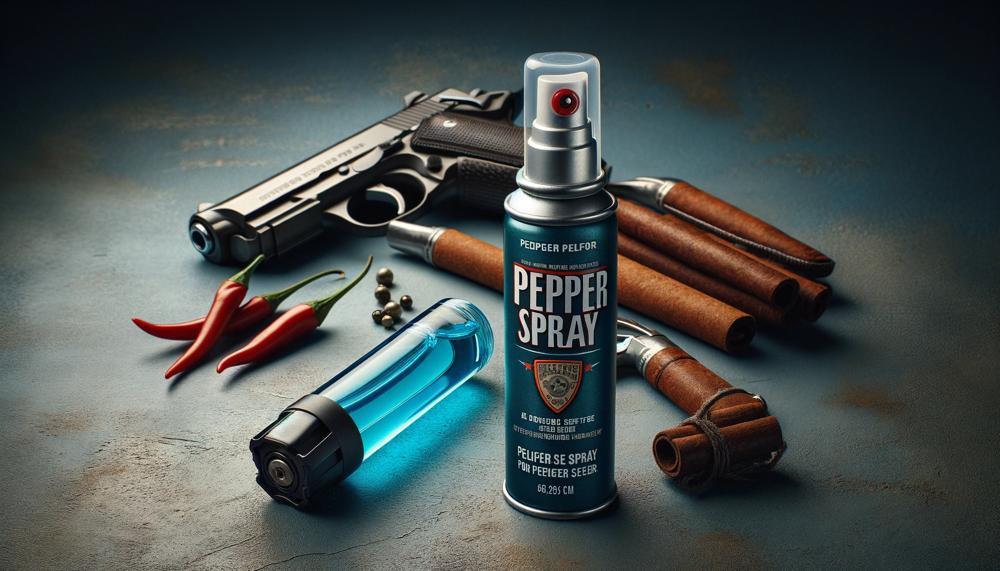
Accuracy:
While both pepper spray and gel can be effective in incapacitating an attacker, pepper spray may offer more accuracy due to its wider range.
It can also be used in a spray pattern, covering a larger area and increasing the chances of hitting the target.
Collateral Damage:
One downside of pepper spray is the potential for collateral damage. When sprayed, it can affect anyone in the immediate vicinity, including innocent bystanders. Gel, on the other hand, is more targeted and has less risk of causing harm to others.
Additional Considerations:
In addition to these factors, there are other important considerations when choosing between pepper spray and gel. These include training, carry method, legal implications, and storage and maintenance. It is vital to understand how to properly use your chosen self-defense tool and be aware of any laws or regulations surrounding its use.
Storing and Maintaining Your Pepper Spray or Gel
Storing and maintaining your pepper spray or gel properly is crucial for its effectiveness in self-defense scenarios. Here are some helpful tips on how to store and maintain your pepper spray or gel with care:
- Designated storage: It is important to have a designated spot for your pepper spray or gel at home. Keep it in a drawer or cabinet, away from direct sunlight, heat, and moisture. This will prevent it from losing its potency over time.
- Wall holder or lockable container: If you want easy access to your pepper spray or gel at home, consider using a wall holder or a lockable container. This will keep it within reach while also ensuring its safety.
- Keychain or belt holster: When on the go, carrying your pepper spray or gel on a keychain or in a belt holster is a convenient option. This way, you will have quick access to it in case of an emergency.
- Check expiration dates: Regularly check the expiration date of your pepper spray or gel. If it has expired, dispose of it properly and replace it with a new canister.
- No refills: Refilling pepper spray or gel canisters is not recommended as they are designed for single use only. Doing so can affect their potency and effectiveness.
- Research local laws: Prior to carrying pepper spray or gel, make sure to research the laws and regulations in your area. Some places may have restrictions on such products, so it is important to be aware of them for your own safety.
By following these tips, you can ensure that your pepper spray or gel remains effective and readily available for use in any self-defense situation. Remember to prioritize safety and legality when storing and maintaining your pepper spray or gel.
It is crucial to properly store and maintain your pepper spray or gel to ensure its effectiveness when needed most. Having a designated place for storage and avoiding direct exposure to sunlight, heat, and moisture are key factors in preserving its potency.
Conclusion
In today’s unpredictable world, ensuring personal safety is a top priority for many individuals. With the increasing rates of crime and dangerous situations, it’s crucial to have a reliable form of defense. Pepper spray and gel are two popular self-defense tools that have been used for decades, but deciding between the two can be daunting.
Upon examining the key differences between pepper spray and gel, including their effectiveness, range, and ease of use, it becomes evident that both options have their own unique advantages and disadvantages. While pepper spray may be more cost-effective and provide wider coverage, pepper gel offers improved accuracy and reduced risk of blowback or inhalation.
When considering which option best suits your personal safety needs, it’s essential to take into account factors such as effective range, performance in different environments, required accuracy when aiming, potential for collateral damage, and personal comfort. It’s also crucial to follow safety precautions when using these tools to ensure their effectiveness.
Ultimately, whether you opt for pepper spray or gel as your self-defense tool of choice will depend on your individual preferences and specific survival requirements. Both options can be highly effective when used correctly and responsibly.
